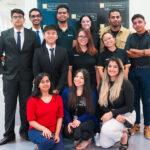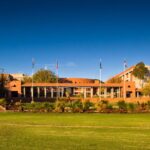
The active involvement of Curtin University with Australian Academic and Research Network (AARNet) has led to the exciting acquisition of one of three AARNet Polycom Immersive Telepresence Systems deployed Australia wide. Curtin University has a system located in the Office of Research and Development (ORD) boardroom in building 100, level 1.
Telepresence has been touted as the next generation of high quality video conferencing and brings with it a suite of new technologies to the meeting experience. Features include; a display of life size images of the face and upper body of remote participants, maintaining a position and proximity perspective that makes the remote participants appear to be sitting on the other side of a conference room table supported by high quality audio and video subsystems. The Telepresence system has specific requirements with respect to bandwidth and quality of service and is deployed in rooms where lighting and sound are carefully controlled. Each of the system screens run at 6 megabits per second for a total conference bandwidth of 36 megabits when in a fully optimised Telepresence call configuration. These factors, combined with tighter control of the user interface elements combine to give a more simplified and immersive video conferencing experience.
The Curtin system is directly connected to the AARNet network to two other units in Canberra and Sydney and will shortly be connected to other interoperable Telepresence systems across Australia and overseas. The system is also configured to work with the AARNet National Video Conferencing Service multipoint conferencing unit (MCU) and as such can facilitate multi-party conferences with other non telepresence video conferencing systems.
Installation of this system will help to improve the University’s collaborations with other research organisations, industry and government without the need to leave the University. It will assist in strengthening links to the broader research and academic communities by encouraging Curtin colleagues to visit the University to access the advanced technology.
The Office of Research and Development thanks Chief Information Officer, Peter Nikoletatos, who has played an instrumental role in bringing about this  opportunity. Appreciation extends to Curtin IT Services’ Audio Visual team and to Chris Hancock, CEO of AARNet and the AARNet Applications and Services team, who assisted in the installation and commissioning of the Telepresence unit.
opportunity. Appreciation extends to Curtin IT Services’ Audio Visual team and to Chris Hancock, CEO of AARNet and the AARNet Applications and Services team, who assisted in the installation and commissioning of the Telepresence unit.
A number of staff in the ORD office will be trained in the use of the new system. If you have any questions or suggestions about how we can make best use of this system, please direct these to the director of administration and finance at the Office of Research and Development, Tony Tate.


